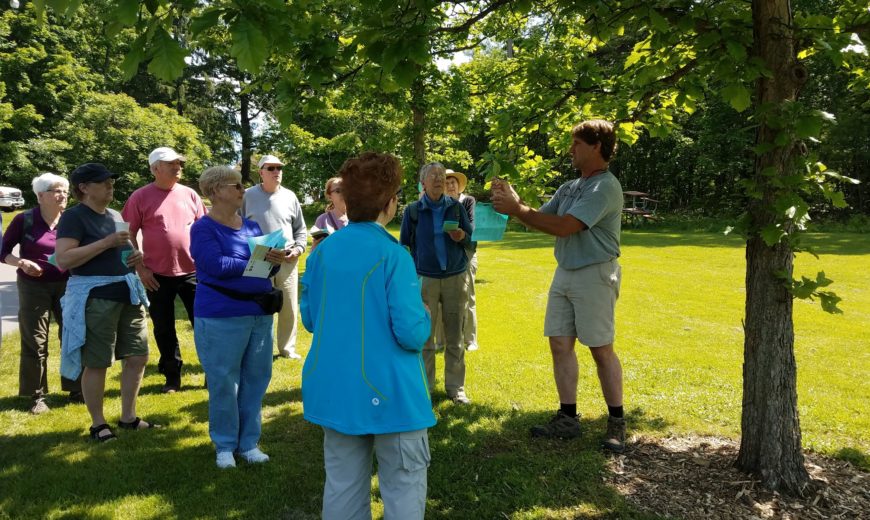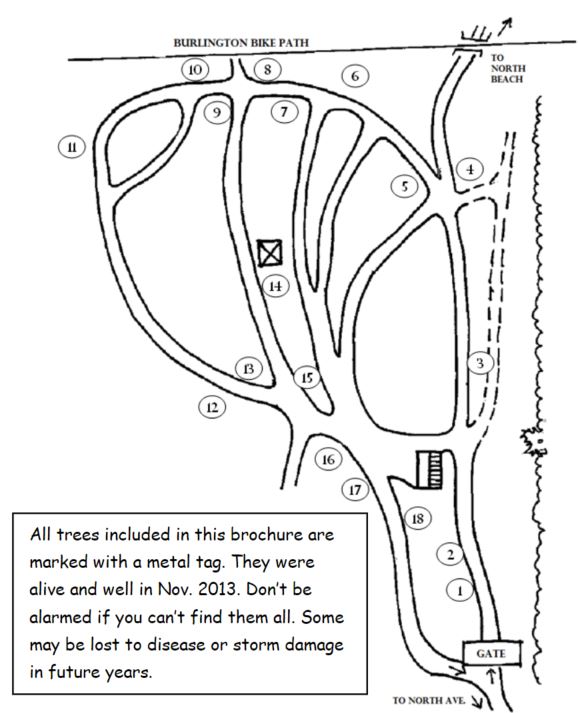North Beach Tree Walk

Did you miss the Annual Tree Walk on June 9, 2018 with the City Arborist and Branch Out Burlington!?
Not to worry. You can do the self guided tour! Use this map to guide you and check out the descriptions below.
If you’re interested in learning more about trees in other locations, you can find all the archived Tree Walks on Branch Out Burlington’s website!
- American Butternut (Juglans cinerea) – a.k.a. “white walnut”; it grows to 100 feet, lives about 80 years and has pinnately compound leaves. Its lighter-colored wood is less valuable compared to black walnut, but is used for interiors, cabinetwork and furniture. Butternuts are threatened by a canker (fungal disease) which eventually kills the tree.
- Swamp White Oak (Quercus bicolor) – Generally grows in moist to swampy bottomland soils. It can reach 50 to 70 feet tall with trunks of 1 to 3 feet in diameter. The leaves are 5 to 6 inches long and 2 to 4 inches wide. The margin is irregularly and shallowly lobed and the lower surface is hairy. Long-stemmed oval acorns usually grow in pairs.
- Heritage River Birch (Betula nigra ‘Heritage’) – Can grow up to 80 feet tall. The trunk is commonly divided into several arching limbs, forming an irregular crown. The leaves are irregularly oval, 1.5-3 inches long and 1-2 inches wide, with coarse, doubly toothed margins. The bark on young trees is pinkish to reddish brown and on older trees gray to black and scaly.
- Kentucky Coffeetree (Gymnocladus dioica) – Grows to 75-100 feet tall, and produces 6-10 inches long seed pods. Leaves are bi-pinnately compound and twigs are very coarse. Pioneers roasted the seeds to make coffee and used its wood for fence posts due to its rot resistance.
- Bur Oak (Quercus macrocarpa) – a.k.a. “mossycup” oak because of the fringed rim on the acorns. Growing slowly to about 75 feet with an equally broad spread, it is a majestic tree for large spaces. Native to North America, its wood is used for floors, furniture and boat decks.
- White Pine (Pinus strobus) – Can reach heights up to 140 feet tall and live up to 200 years. It’s the most common conifer in Vermont, and is the only eastern native conifer with 5 needles to a bunch. In pre-Revolutionary times it was used for ship masts because of its strength and light weight.
- Green Ash ‘Patmore’ (Fraxinus pennsylvanica ‘Patmore’) – The species commonly grows in moist bottomlands or river bottoms. Rarely grows over 60 feet tall or lives more than 100 years. Bark is grayish-brown with finely intersecting furrows. Leaves are compound with 7-9 leaflets; leaf scar is straight or slightly concave on the top. This cultivar is a popular urban tree. All ash species are at risk of damage from the Emerald Ash Borer beetle, which has been found in VT but not yet (as of May 31, 2018) in Chittenden County. For more info go to vtinvasives.org/land/emerald-ash-borer-vermont
- Northern Red Oak (Quercus rubra) – Leaves have 5-11 lobes with pointed tips tapered from a broad base. Acorn is 1 inch long, with shallow cup and bitter taste. Bark is smooth on young trees; has unbroken vertical ridges on older ones. Red oak is the most common oak in Vermont, and is found mainly in the warmer areas of the state.
- Red or Swamp Maple (Acer rubrum) – Often grows in swampy places but tolerates a wide range of soil types. The leaves have 3-5 lobes and turn bright red in fall. It grows to 60- 90 feet and can live 100 years. Many red maple hybrids and cultivars grace our city’s streets and parks.
- Eastern White Oak (Quercus alba) – has hairless leaves with 7-9 rounded lobes. The acorn is longer than wide and tastes sweet; they can be eaten as a nut or ground into flour. Bark is scaly with narrow with irregular ridges. White oak staves are used for making whiskey barrels due to their watertight qualities.
- Sugar Maple (Acer saccharum) – Vermont’s state tree, Canada’s national tree, best known for its maple sap and red to orange fall foliage. It is slow growing, reaching 60 –75 feet tall with an upright rounded shape. It has a shallow root system, and does not grow well in dry compacted soil. It tolerates shade, but not air pollution or road salt. It is susceptible to various insect pests, including the Asian longhorned beetle – an invasive pest that has not yet been found in VT.
- NO TAG! **Norway Maple** (Acer pennsylvanicum) 2018 update: the Boxelder (Acer negundo) tree formerly tagged as #12 has died. Instead, look for the small Norway maple tree growing on the bank at the edge of the campground that’s too small to tag. This species is non-native and highly invasive due to its extremely successful ability to spread its seeds.
- Common Hackberry (Celtis occidentalis) – A native tree indigenous to the Champlain Valley, commonly found in back yards, hedgerows and along the streets of Burlington. It is tolerant of urban conditions. It is a medium/large tree (50 –80 feet) that has a wide spread similar to the vase-like shape of an elm. It is related to hops and hemp/marijuana.
- White Ash (Fraxinus americana) – Finely furrowed gray bark with intersecting diamond patterns. Leaves are compound with 7-9 leaflets; leaf scar is deeply concave or v-notched on the top. The wood is used for hockey sticks, tennis racquets and baseball bats because wood is strong, pliable and light. All ash species are at risk of damage from the Emerald Ash Borer beetle, which has been found in VT but not yet (as of May 31, 2018) in Chittenden County. For more info go to www.vtinvasives.org/land/emerald-ash-borer-vermont
- American Beech (Fagus grandifolia) – Has smooth, thin, slate gray bark (ideal for carving initials, unfortunately!). It can reach over 80 feet and live 200 years. Beech trees in Vermont are increasingly susceptible to damage from an insect-fungus complex (beech scale insect which vectors the Nectria canker) attacking trees over 10 inches in diameter.
- Gray Birch (Betula populifolia) – A relatively small tree with one or several stems; has chalky white bark and triangular long-pointed leaves. Often mistaken for paper birch, gray birch trunks are marked by dark chevrons at bases of branches, as well as the narrow horizontal marks (‘lenticels’) characteristic of all birches. This tree has had the outer bark peeled off, a common example of ‘people pressure’ impact on birch trees.
- American Basswood (Tilia americana) – native tree growing to 90 feet and lives 200 years. It produces highly fragrant flowers in July, which are used to make a soothing tea. It has large, heart-shaped leaves and a symmetrical pyramidal tree form. It is salt-tolerant and is related to little-leaf linden ( cordata) and silver linden (T. tomentosa), both are popular urban trees.
- Shagbark Hickory (Carya ovata) – Grows to 90 feet and lives up to 200 years. Gray bark is distinctly shaggy, with long curled strips. Leaves are compound with mostly 5 leaflets. It grows best in warmer parts of VT, especially in the Champlain Valley. Cord of hickory wood is equivalent in fuel value to a ton of coal. The wood is often used for smoking meats.
All trees included in this brochure are marked with a metal tag (except as noted). They were alive and well in June, 2018. Don’t be alarmed if you can’t find them all. Some may be lost to disease or storm damage in future years. In 1914 the city fathers, alarmed at the rapidly diminishing public access to the sandy beach along the lakeshore, began looking for a public park site. Four years later a beach location on the Arthur farm became available and on July 17, 1918 the Parks Department purchased a large block of the farm consisting of a long stretch of sandy beach, a large wooded area and an open field, later to become a campground. In 1919 the city spent $2000 to build a bath house. The campground for “automobile tourists” as they were referred to was established in 1921 and has been a popular feature of the beach park ever since. Entrance fees were first charged in 1935. The city constructed a new bath house in 1964 which was replaced again in 1998. In 1977 the Parks Department purchased an additional 15 acres from the Episcopal Diocese. The Burlington Bike Path/Greenway was built in 1987 and renovated in 2017-18. (From Historic Guide to Burlington Neighborhoods, Chittenden County Historical Society)
A Project by Branch Out Burlington! Enjoy your walk! The Trees of North Beach Our Mission: We are a group of volunteers who help plant and care for the trees of Burlington. Our goal is to promote a vision of a city graced with a variety of beautiful and healthy trees, and a citizenry actively involved with the perpetual expansion and preservation of our urban forest. Want to get involved? Everyone is welcome at our monthly meetings. Find us on Facebook.
Tax deductible donations can be made out to Branch Out Burlington! and sent to 93 Howard St., Burlington, VT 05401. Visit our website at www.branchoutburlington.org
Produced by: Volunteers of Branch Out Burlington! With support from: Burlington Department of Parks, Recreation & Waterfront. Copyright © 2018 Branch Out Burlington!

